ISABEL DEBRE and WAFAA SHURAFA
Thu, December 14, 2023
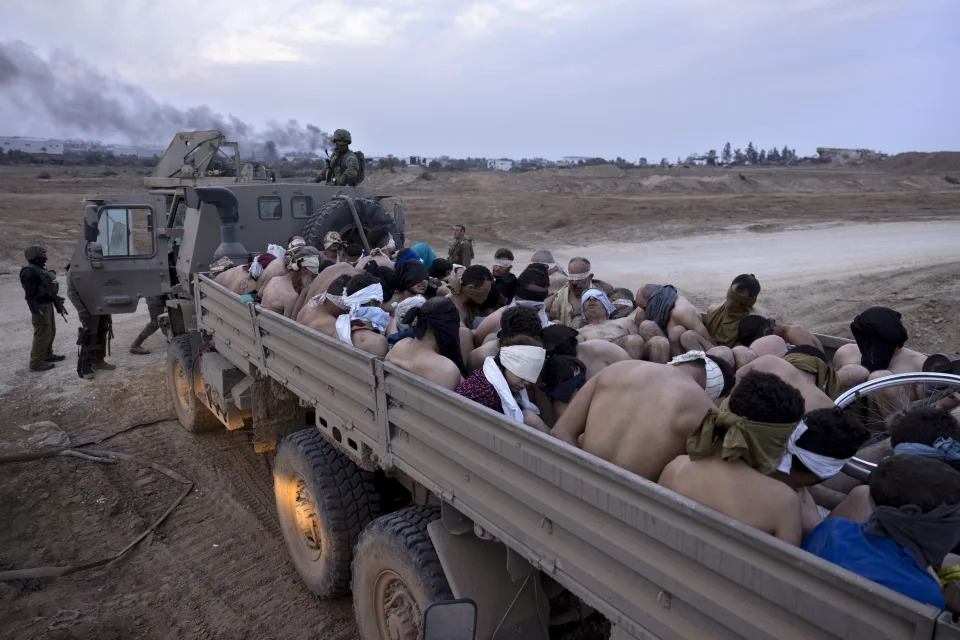
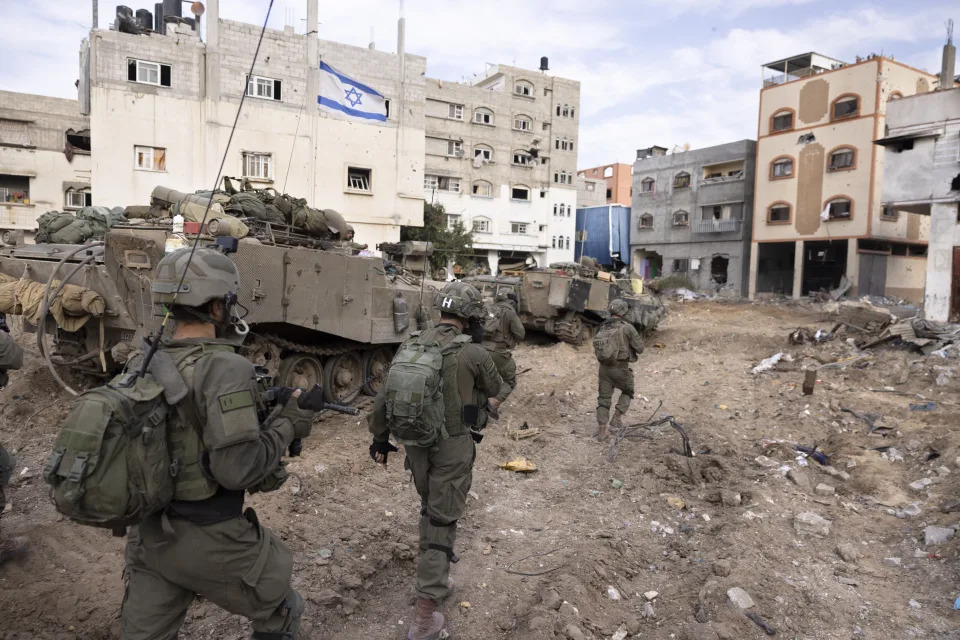
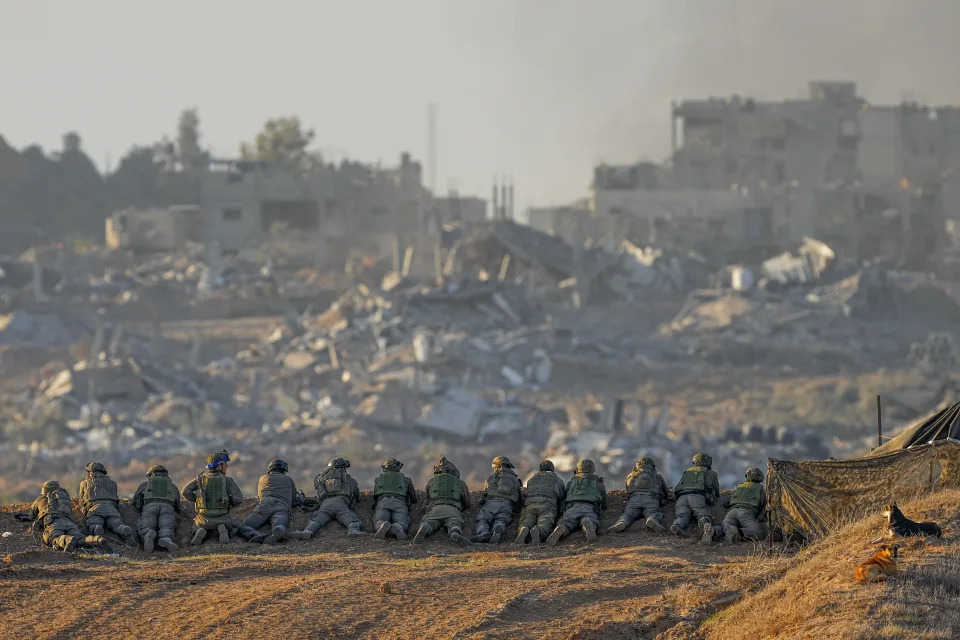
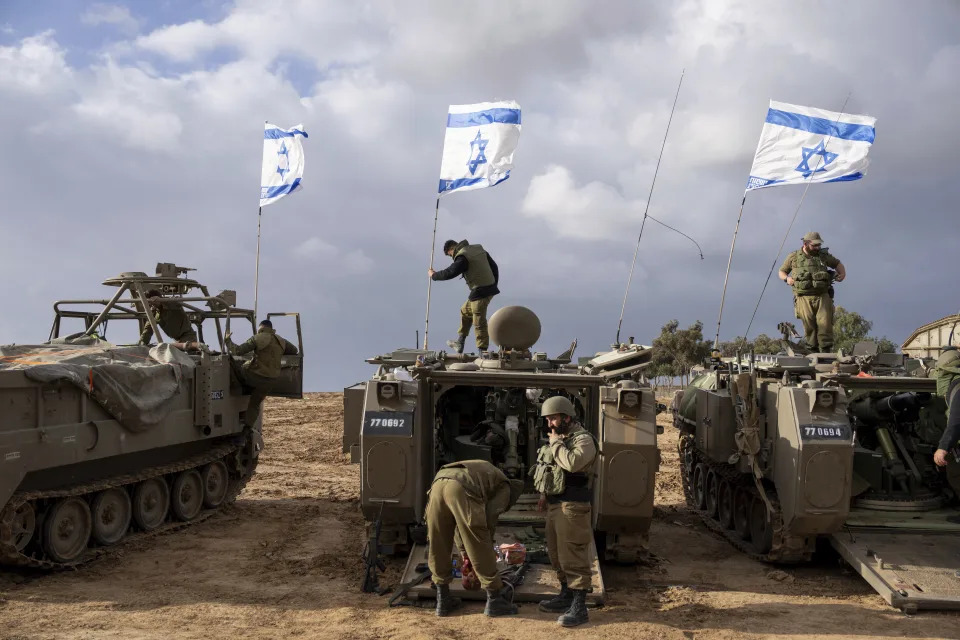
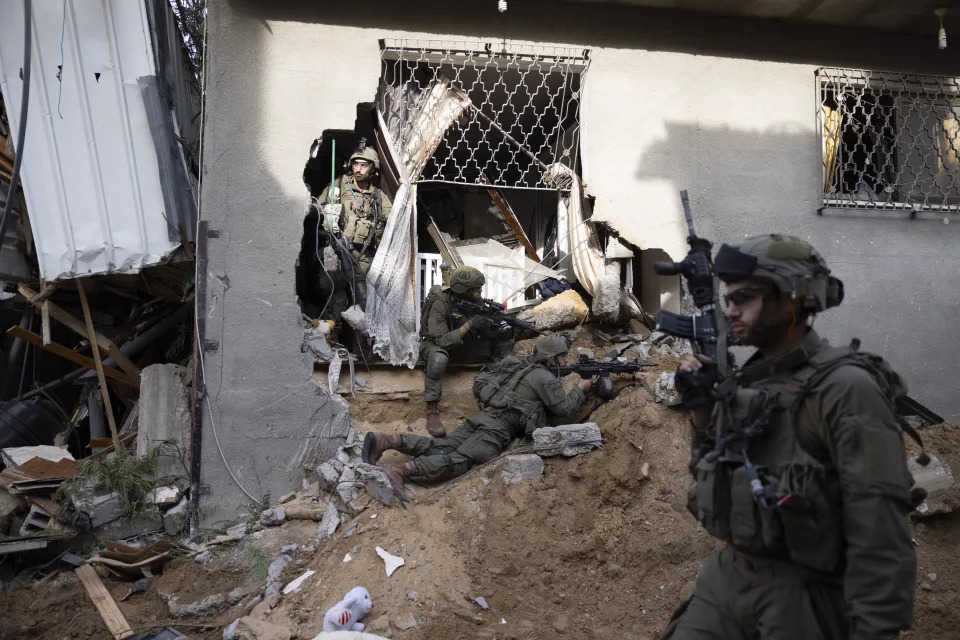
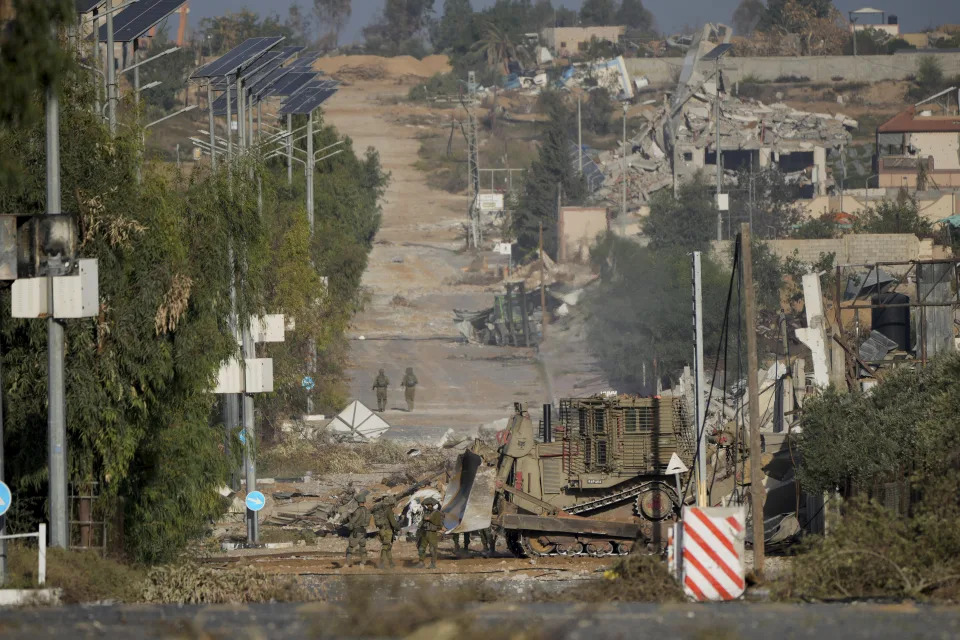
Israeli soldiers stand on Salah al-Din road in central Gaza Strip on Friday, Nov. 24, 2023, as the temporary ceasefire went into effect. The Israeli military has rounded up hundreds of Palestinians across the northern Gaza Strip, separating families and forcing men to strip to their underwear before trucking some to an undisclosed location. The roundups have laid bare an emerging tactic in Israel's ground offensive in Gaza, experts say, as the military seeks to solidify control in evacuated areas in the north and collect intelligence about Hamas operations nearly 10 weeks after the group's deadly Oct. 7 attack on southern Israel.
(AP Photo/Hatem Moussa, File)
DEIR AL-BALAH, Gaza Strip (AP) — The Israeli military has rounded up hundreds of Palestinians across the northern Gaza Strip, separating families and forcing men to strip to their underwear before trucking some to a detention camp on the beach, where they spent hours, in some cases days, subjected to hunger and cold, according to human rights activists, distraught relatives and released detainees themselves.
Palestinians detained in the shattered town of Beit Lahiya, the urban refugee camp of Jabaliya and neighborhoods of Gaza City said they were bound, blindfolded and bundled into the backs of trucks. Some said they were taken to the camp at an undisclosed location, nearly naked and with little water.
“We were treated like cattle, they even wrote numbers on our hands," said Ibrahim Lubbad, a 30-year-old computer engineer arrested in Beit Lahiya on Dec. 7 with a dozen other family members and held overnight. “We could feel their hatred.”
The roundups have laid bare an emerging tactic in Israel’s ground offensive in Gaza, experts say, as the military seeks to solidify control in evacuated areas in the north and collect intelligence about Hamas operations nearly 10 weeks after the group’s deadly Oct. 7 attack on southern Israel. Militants killed about 1,200 people and abducted over 240 that day.
In response to questions about alleged mistreatment, the Israeli military said that detainees were “treated according to protocol” and were given enough food and water. The army spokesman, Rear Adm. Daniel Hagari, said the men are questioned and then told to dress, and that in cases where this didn't happen, the military would ensure it doesn't occur again. Those believed to have ties to Hamas are taken away for further interrogation, and dozens of Hamas members have been arrested so far, he said.
Photos and video showing Palestinian men kneeling in the streets, heads bowed and hands bound behind their backs, sparked outrage after spreading on social media.
To Palestinians, it is a stinging indignity. Among those rounded up were boys as young as 12 and men as old as 70, and they included civilians who lived ordinary lives before the war, according to interviews with 15 families of detainees.
“My only crime is not having enough money to flee to the south,” said Abu Adnan al-Kahlout, an unemployed 45-year-old with diabetes and high blood pressure in Beit Lahiya. He was detained Dec. 8 and released after several hours when soldiers saw he was too faint and nauseated to be interrogated.
Israeli forces have detained at least 900 Palestinians in northern Gaza, estimated Ramy Abdu, founder of the Geneva-based Euro-Med Human Rights Monitor, which has worked to document the arrests. Based on testimony it collected, the group presumes Israel is holding most detainees from Gaza at the Zikim military base just north of the enclave.
The Israeli military declined comment on where the detainees were taken.
Palestinians cowered with their families for days as Israel poured heavy machine-gun fire into Beit Lahiya and Jabaliya, the firefights with Hamas militants stranding families in their homes without electricity, running water, fuel or communications and internet service.
“There are corpses all over the place, left out for three, four weeks because no one can reach them to bury them before the dogs eat them,” said Raji Sourani, a lawyer with the Palestinian Center for Human Rights in Gaza. He said he saw dozens of dead bodies as he made his way from Gaza City to the southern border with Egypt last week.
Palestinians recounted soldiers going door to door with dogs, using loudspeakers to call on families to come outside. In most cases, women and children are told to walk away to find shelter.
Some released detainees described enduring humiliating stretches of near-nudity as Israeli troops took the photos that later went viral. Some guessed they were driven several kilometers (miles) before being dumped in cold sand.
Released detainees said they were exposed to the chill of night and repeatedly questioned about Hamas activities that most couldn't answer. Soldiers kicked sand in their faces and beat those who spoke out of turn.
Several Palestinians held for 24 hours or less said they had no food and were forced to share three 1.5-liter bottles with some 300 fellow detainees.
Darwish al-Ghabrawi, a 58-year-old principal at a U.N. school, fainted from dehydration. Mahmoud al-Madhoun, a 33-year-old shopkeeper, said the only moment that gave him hope was when soldiers released his son, realizing he was just 12.
Returning home brought its own horrors. Israeli soldiers dropped detainees off after midnight without their clothes, phones or IDs near what appeared to be Gaza's northern border with Israel, those released said, ordering them to walk through a landscape of destruction, tanks stationed along the road and snipers perched on roofs.
“It was a death sentence,” said Hassan Abu Shadkh, whose brothers, 43-year-old Ramadan and 18-year-old Bashar, and his 38-year-old cousin, Naseem Abu Shadkh, walked shoeless over jagged mounds of debris until their feet bled.
Naseem, a farmer in Beit Lahiya, was shot and killed by an Israeli sniper as they made their way to a U.N. school in Beit Lahiya, Abu Shadkh said. His brothers were forced to leave their cousin’s body in the middle of the road.
Israeli officials say they have reason to be suspicious of Palestinians remaining in northern Gaza, given that places like Jabaliya and Shijaiyah, in eastern Gaza City, are well-known Hamas bastions.
Human rights groups say mass arrests should be investigated.
“Civilians must only be arrested for absolutely necessary and imperative reasons for security. It's a very high threshold," said Omar Shakir, Human Rights Watch’s regional director.
—-
This story has been updated to correct the name of the Euro-Med Human Rights Monitor. It is Ramy Abdu, not Rami Abdo.
—-
DeBre reported from Jerusalem.
—-
Full AP coverage at https://apnews.com/hub/israel-hamas-war
What do we know about the shocking videos of Palestinian prisoners stripped to their underwear?
Sophia Khatsenkova
Wed, December 13, 2023

What do we know about the shocking videos of Palestinian prisoners stripped to their underwear?
Several pictures and videos that have emerged online in recent days show dozens of Palestinian men being arrested, some stripped down to their underwear and forced to sit or kneel on the ground.
Some people have pointed to the shocking video as evidence of Israel’s human rights violations and humiliating treatment of prisoners.
But this video also raised questions about its authenticity. "It looks fake... Nobody is restrained and Israel blindfolds all prisoners," one Twitter user commented.
The Cube decided to take a closer look.
DEIR AL-BALAH, Gaza Strip (AP) — The Israeli military has rounded up hundreds of Palestinians across the northern Gaza Strip, separating families and forcing men to strip to their underwear before trucking some to a detention camp on the beach, where they spent hours, in some cases days, subjected to hunger and cold, according to human rights activists, distraught relatives and released detainees themselves.
Palestinians detained in the shattered town of Beit Lahiya, the urban refugee camp of Jabaliya and neighborhoods of Gaza City said they were bound, blindfolded and bundled into the backs of trucks. Some said they were taken to the camp at an undisclosed location, nearly naked and with little water.
“We were treated like cattle, they even wrote numbers on our hands," said Ibrahim Lubbad, a 30-year-old computer engineer arrested in Beit Lahiya on Dec. 7 with a dozen other family members and held overnight. “We could feel their hatred.”
The roundups have laid bare an emerging tactic in Israel’s ground offensive in Gaza, experts say, as the military seeks to solidify control in evacuated areas in the north and collect intelligence about Hamas operations nearly 10 weeks after the group’s deadly Oct. 7 attack on southern Israel. Militants killed about 1,200 people and abducted over 240 that day.
In response to questions about alleged mistreatment, the Israeli military said that detainees were “treated according to protocol” and were given enough food and water. The army spokesman, Rear Adm. Daniel Hagari, said the men are questioned and then told to dress, and that in cases where this didn't happen, the military would ensure it doesn't occur again. Those believed to have ties to Hamas are taken away for further interrogation, and dozens of Hamas members have been arrested so far, he said.
Photos and video showing Palestinian men kneeling in the streets, heads bowed and hands bound behind their backs, sparked outrage after spreading on social media.
To Palestinians, it is a stinging indignity. Among those rounded up were boys as young as 12 and men as old as 70, and they included civilians who lived ordinary lives before the war, according to interviews with 15 families of detainees.
“My only crime is not having enough money to flee to the south,” said Abu Adnan al-Kahlout, an unemployed 45-year-old with diabetes and high blood pressure in Beit Lahiya. He was detained Dec. 8 and released after several hours when soldiers saw he was too faint and nauseated to be interrogated.
Israeli forces have detained at least 900 Palestinians in northern Gaza, estimated Ramy Abdu, founder of the Geneva-based Euro-Med Human Rights Monitor, which has worked to document the arrests. Based on testimony it collected, the group presumes Israel is holding most detainees from Gaza at the Zikim military base just north of the enclave.
The Israeli military declined comment on where the detainees were taken.
Palestinians cowered with their families for days as Israel poured heavy machine-gun fire into Beit Lahiya and Jabaliya, the firefights with Hamas militants stranding families in their homes without electricity, running water, fuel or communications and internet service.
“There are corpses all over the place, left out for three, four weeks because no one can reach them to bury them before the dogs eat them,” said Raji Sourani, a lawyer with the Palestinian Center for Human Rights in Gaza. He said he saw dozens of dead bodies as he made his way from Gaza City to the southern border with Egypt last week.
Palestinians recounted soldiers going door to door with dogs, using loudspeakers to call on families to come outside. In most cases, women and children are told to walk away to find shelter.
Some released detainees described enduring humiliating stretches of near-nudity as Israeli troops took the photos that later went viral. Some guessed they were driven several kilometers (miles) before being dumped in cold sand.
Released detainees said they were exposed to the chill of night and repeatedly questioned about Hamas activities that most couldn't answer. Soldiers kicked sand in their faces and beat those who spoke out of turn.
Several Palestinians held for 24 hours or less said they had no food and were forced to share three 1.5-liter bottles with some 300 fellow detainees.
Darwish al-Ghabrawi, a 58-year-old principal at a U.N. school, fainted from dehydration. Mahmoud al-Madhoun, a 33-year-old shopkeeper, said the only moment that gave him hope was when soldiers released his son, realizing he was just 12.
Returning home brought its own horrors. Israeli soldiers dropped detainees off after midnight without their clothes, phones or IDs near what appeared to be Gaza's northern border with Israel, those released said, ordering them to walk through a landscape of destruction, tanks stationed along the road and snipers perched on roofs.
“It was a death sentence,” said Hassan Abu Shadkh, whose brothers, 43-year-old Ramadan and 18-year-old Bashar, and his 38-year-old cousin, Naseem Abu Shadkh, walked shoeless over jagged mounds of debris until their feet bled.
Naseem, a farmer in Beit Lahiya, was shot and killed by an Israeli sniper as they made their way to a U.N. school in Beit Lahiya, Abu Shadkh said. His brothers were forced to leave their cousin’s body in the middle of the road.
Israeli officials say they have reason to be suspicious of Palestinians remaining in northern Gaza, given that places like Jabaliya and Shijaiyah, in eastern Gaza City, are well-known Hamas bastions.
Human rights groups say mass arrests should be investigated.
“Civilians must only be arrested for absolutely necessary and imperative reasons for security. It's a very high threshold," said Omar Shakir, Human Rights Watch’s regional director.
—-
This story has been updated to correct the name of the Euro-Med Human Rights Monitor. It is Ramy Abdu, not Rami Abdo.
—-
DeBre reported from Jerusalem.
—-
Full AP coverage at https://apnews.com/hub/israel-hamas-war
What do we know about the shocking videos of Palestinian prisoners stripped to their underwear?
Sophia Khatsenkova
Wed, December 13, 2023

What do we know about the shocking videos of Palestinian prisoners stripped to their underwear?
Several pictures and videos that have emerged online in recent days show dozens of Palestinian men being arrested, some stripped down to their underwear and forced to sit or kneel on the ground.
Some people have pointed to the shocking video as evidence of Israel’s human rights violations and humiliating treatment of prisoners.
But this video also raised questions about its authenticity. "It looks fake... Nobody is restrained and Israel blindfolds all prisoners," one Twitter user commented.
The Cube decided to take a closer look.
Where did these arrests take place?
There have been multiple reports. An Israeli government spokesperson claimed it was taken in the Hamas stronghold of Jabaliya.
Meanwhile, according to Palestinians, the images were filmed in the northern town of Beit Lahiya.
The Geolocation sleuths, Geoconfirmed also found the video was taken in the southern part of the town Beit Lahiya.
We found these images first appeared online on 7 December. However, it is difficult to confirm the circumstances in which these arrests took place, their exact date, or the person behind the video.
There have been multiple reports. An Israeli government spokesperson claimed it was taken in the Hamas stronghold of Jabaliya.
Meanwhile, according to Palestinians, the images were filmed in the northern town of Beit Lahiya.
The Geolocation sleuths, Geoconfirmed also found the video was taken in the southern part of the town Beit Lahiya.
We found these images first appeared online on 7 December. However, it is difficult to confirm the circumstances in which these arrests took place, their exact date, or the person behind the video.
Who are some of the prisoners seen in the video?
The international NGO Euro-Mediterranean Human Rights Monitor indicated that it had recognised several civilians, including a school director and doctors.
They were taken from two schools, both of which are affiliated with the United Nations Relief and Works Agency for Palestine Refugees in the Near East (UNRWA), the rights group said in a statement.
According to his employer, at least one journalist from The New Arab, a media outlet based in London, is among the prisoners seen in the video.
Other members of the journalists' family were also arrested according to the Committee to Protect Journalists.
The Committee to Protect Journalists reminded that the New Arab is one of the few media outlets still present in the north of the Gaza Strip.
In an interview with CNN, Hani Almadhoun, director of philanthropy for the US arm of the United Nations Relief and Works Agency for Palestine Refugees in the Near East (UNRWA USA) said he knew a dozen people pictured in circulating images, including his brother. He claimed his brother is a shopkeeper and is not affiliated with Hamas.
The international NGO Euro-Mediterranean Human Rights Monitor indicated that it had recognised several civilians, including a school director and doctors.
They were taken from two schools, both of which are affiliated with the United Nations Relief and Works Agency for Palestine Refugees in the Near East (UNRWA), the rights group said in a statement.
According to his employer, at least one journalist from The New Arab, a media outlet based in London, is among the prisoners seen in the video.
Other members of the journalists' family were also arrested according to the Committee to Protect Journalists.
The Committee to Protect Journalists reminded that the New Arab is one of the few media outlets still present in the north of the Gaza Strip.
In an interview with CNN, Hani Almadhoun, director of philanthropy for the US arm of the United Nations Relief and Works Agency for Palestine Refugees in the Near East (UNRWA USA) said he knew a dozen people pictured in circulating images, including his brother. He claimed his brother is a shopkeeper and is not affiliated with Hamas.
What does Israel say?
During a press conference on Sunday, the spokesperson for Israel Defense Forces acknowledged that mass arrests have taken place but assured the detainees were “treated in accordance with international law”, justifying stripping them down to by saying they were searching for explosive devices.
The Euro-Mediterranean Human Rights Monitor said the men were “arbitrarily arrested” after Israeli forces surrounded two shelters inside the schools in Beit Lahiya.
Asked about the video, a spokesman for the Israeli government told the BBC the men detained were all of military age and had been "discovered in areas that civilians were supposed to have evacuated weeks ago".
A senior Israeli official told the Times of Israel that the photos of Palestinian men being stripped to their underwear after their arrest by the IDF in Gaza might be “uncomfortable.”
Under international humanitarian law, all prisoners of war need to be treated humanely.
The act of publishing these humiliating images could be a violation of the Geneva Convention, especially considering the presence of civilians.
No comments:
Post a Comment